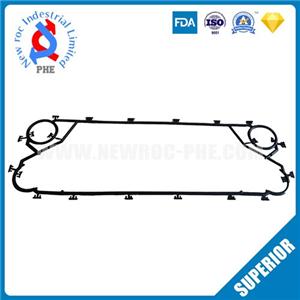Six types of fouling in plate heat exchanger and its influence on heat exchanger
Compared with the shell-and-tube heat exchanger of another kind of heat exchange equipment, the plate heat exchanger is less prone to fouling. This is because the plate heat exchanger has more internal turbulence than the shell-and-tube heat exchanger and has a strong self-cleaning ability. However, the equipment of the plate heat exchanger will also become fouled during long-term use. Fouling will affect the heat transfer efficiency of the plate heat exchanger of the plate heat exchanger. Generally, there are the following types of fouling, let's take a look:
1. Corrosion dirt: Corrosive fluid or fluid containing corrosive impurities corrodes the surface of the heat exchanger plate and produces dirt. Generally, the degree of corrosion depends on the composition, temperature and pH of the fluid to be treated. value.
2. Particle fouling: the accumulation of solid particles suspended in the fluid on the heat exchange surface. This fouling also includes the sedimentation layer formed by the larger solid particles on the surface of the horizontal heat exchanger plate due to gravity, the so-called sedimentation fouling And the deposition of other colloidal particles.
3. Chemical reaction dirt: the dirt produced by the chemical reaction on the surface of the heat transfer plate. The surface material of the heat transfer plate does not participate in the reaction, but it can be used as a catalyst for the chemical reaction.
4. Crystallization fouling: The deposits formed by the crystallization of inorganic salts dissolved in the fluid on the surface of the plates of the plate heat exchanger usually occur during supersaturation or cooling. Typical fouling such as calcium carbonate and sulfuric acid on the cooling water side Calcium and silica fouling layer.
5. Biological fouling: Except for the seawater plate type cooling device, general biological fouling refers to microbial fouling, which may produce slime, which in turn provides conditions for the reproduction of biological fouling, which is very sensitive to temperature. Under suitable temperature conditions, biological fouling can generate a considerable thickness of fouling layer.
6. Solidification dirt: the dirt formed by the solidification of the fluid on the surface of the supercooled heat exchange plate, for example, when the water is below the freezing point and solidifies into ice on the surface of the heat exchange plate, the uniformity of the temperature distribution is correct for this Dirt has a great influence.
The several structural types of the plate heat exchanger are shown above, no matter which type of fouling it is, it will affect the normal use of the plate heat exchanger. If the plate heat exchanger fouls, it will have a certain impact on the heat exchanger itself and its working efficiency:
1. Reduce the heat transfer effect of the plate heat exchanger. The thermal conductivity of carbon steel is 464-522W/(mk), but the thermal conductivity of carbonate scale is 0464~0697W/(mk), which is only about 1% of carbon steel's scale or The thermal conductivity of other sediments is much lower than that of metals, so when scale or other sediments cover the surface of the heat exchange plates of the plate heat exchanger plate condenser, it will greatly reduce the heat exchange of the plate heat exchanger plate condenser Efficiency, affecting quality;
2. Reduce the amount of circulating water. The sediment or microbial sludge covers the heat exchange tube wall in the plate condenser of the plate heat exchanger and even blocks the flow channel of the plate heat exchanger, making the cross-sectional area and flux of the circulating water channel smaller. Thereby, the heat exchange effect of the plate condenser of the plate heat exchanger is further reduced and the cooling time is extended;
3. Reduce the use effect of water treatment chemicals. Deposits and microbial sludge cover the surface of the metal, preventing water treatment chemicals such as corrosion inhibitors, scale inhibitors and fungicides in the water from reaching the metal surface of the plate heat exchanger plate condenser. Corrosion inhibition, scale inhibition and bactericidal effects, and some microorganisms will also react with some water treatment chemicals, thereby destroying and reducing the use of these chemicals;
4. Accelerate the generation of corrosion deposits and microorganisms, which promotes the formation of concentration corrosion batteries and the generation of under-scaling corrosion, which intensifies the corrosion rate of the plate condenser metal of the plate heat exchanger;
5. Shorten the service life of the plate heat exchanger. Deposits and microbial sludge cover the surface of the plate condenser of the plate heat exchanger to prevent the effective heat exchange of the plate heat exchanger and cause metal fatigue; on the other hand, corrosion will occur. Leading to the thinning of the heat exchange plates of plate condensers such as plate heat exchangers, especially under-scaling corrosion and rust tumors will also lead to equipment perforation and leakage;
6. Increasing operating costs. In order to maintain sufficient heat exchange efficiency for the plate heat exchanger, measures such as increasing the amount of water must be taken. At the same time, for repairing damage caused by corrosion and other reasons, it will inevitably need to increase the cost, thereby increasing the cost of industrial equipment. Operating costs.




